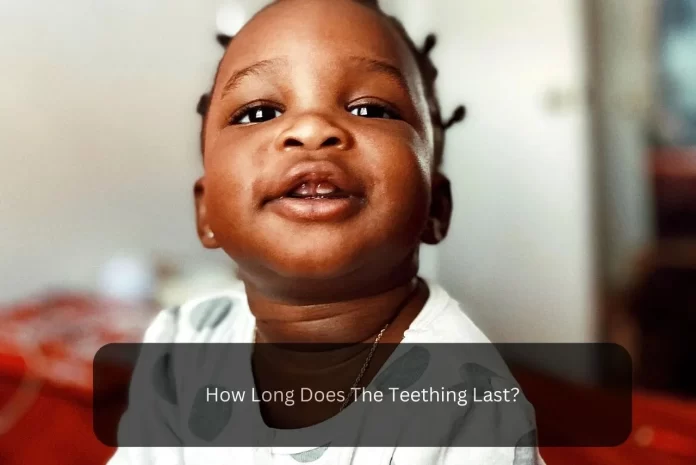Teething is a natural process that every baby goes through, signaling the gradual emergence of their first set of teeth. It’s a journey filled with curiosity, wonder, and sometimes a touch of apprehension for parents and caregivers. One common question that often arises during this phase is, “How long does the teething last?” This introduction aims to provide insights into this intriguing developmental stage while shedding light on the duration of the teething process.
Teething is more than just the appearance of teeth; it’s a fundamental milestone that showcases a baby’s growth and development. As these tiny teeth push their way through the gums, they pave the way for a range of new experiences and interactions. Understanding the timeline of teething can help parents anticipate what lies ahead and provide appropriate care and comfort for their little ones.
Common Signs and Symptoms of Teething: How Long Does the Teething Last
Teething is a transformative phase in a baby’s life, but it often comes with a set of noticeable signs and symptoms that can indicate the emergence of those precious first teeth. Understanding these indicators can help parents and caregivers offer the appropriate care and support during the teething journey, which can last several months. Here are some common signs and symptoms to look out for:
- Drooling: Excessive drooling is a hallmark of teething. Babies might produce more saliva than usual, which can lead to wet chins and clothing. Keep a bib handy to help keep them comfortable and dry.
- Irritability: Teething can be uncomfortable, and babies often express their discomfort through irritability. They might become fussier than usual, experience mood changes, or display increased sensitivity.
- Chewing on Objects: The pressure from teeth pushing against the gums can cause discomfort. Babies instinctively alleviate this discomfort by chewing on objects. You might notice them gnawing on their fingers, toys, or anything within their reach.
- Gum Swelling and Redness: As teeth move beneath the gumline, the surrounding tissue might become swollen and red. Gently massaging the gums with clean fingers can provide some relief.
- Changes in Sleep Patterns: Discomfort from teething can disrupt sleep patterns. Babies who previously slept soundly might experience more wakeful nights or altered sleep routines.
- Loss of Appetite: The pressure and discomfort in the gums can lead to a temporary loss of appetite. Offer soft foods and maintain hydration to ensure they’re getting the necessary nutrition.
- Ear Pulling and Cheek Rubbing: Teething discomfort can radiate to the ears, causing babies to pull on their ears. They might also rub their cheeks or jaw area to seek relief.
- Runny Nose: Some babies experience a slight increase in nasal congestion or a runny nose during teething. This is believed to be linked to the increased production of saliva.
- Mild Temperature: While not usually indicative of a fever, a slight elevation in body temperature might occur during teething. If the temperature is significantly high, consult a healthcare professional.
- Changes in Stool: Teething can sometimes cause changes in bowel movements, including loose stools. However, any severe changes should be discussed with a pediatrician.
- Gnaw Marks: Chewing on objects might lead to noticeable gnaw marks on toys, teething rings, or even on their own fingers.
RELATED: How to Flush Excess Potassium
The Teething Timeline:
Teething is a gradual process that typically begins when a baby is around 6 months old. However, it’s essential to note that every child is unique, and teething can start earlier or later. The process usually continues until the primary set of teeth, known as baby teeth or deciduous teeth, is complete. By the age of 3, most children will have their full set of primary teeth.

How long does the teething last as per phases and timeline?
Understanding the different phases of teething can help parents and caregivers prepare for what lies ahead and provide appropriate support to their little ones. So, how long does the teething last, and what are the key phases involved? Let’s explore:
Phase 1: Initial Teething Signs (Around 3-5 Months)
- The teething process often begins with the appearance of early signs, such as increased drooling, mild irritability, and a tendency to chew on objects.
- These preliminary indicators can start as early as 3-5 months, although the timing varies among infants.
- While the first teeth might not be visible yet, the preparation for teething is underway.
Phase 2: Eruption of Lower Central Incisors (Around 6-10 Months)
- Between 6 to 10 months, the lower central incisors, also known as the bottom front teeth, usually emerge.
- This phase can be accompanied by more noticeable symptoms, including gum swelling, increased fussiness, and potential changes in sleep patterns.
- The first appearance of teeth is an exciting milestone for both parents and babies.
Phase 3: Upper Central Incisors and Lateral Incisors (Around 9-13 Months)
- Following the lower central incisors, the upper central incisors (top front teeth) typically start to emerge between 9 to 13 months.
- Lateral incisors, which are adjacent to the central incisors, might also make their appearance during this period.
- As teething progresses, the discomfort can vary, and babies might exhibit increased chewing and gnawing behaviors.
Phase 4: First Molars (Around 12-16 Months)
- Around 12 to 16 months, the first molars, situated at the back of the mouth, begin to come in.
- These larger teeth can cause more noticeable discomfort due to their size and location.
- The cumulative effect of teething might lead to more frequent irritability and restlessness.
Phase 5: Canines (Around 16-20 Months)
- Canines, also known as “fang” teeth, usually appear between 16 to 20 months.
- These pointed teeth can cause unique sensations, and babies might exhibit increased sensitivity in their mouth.
- The teething process might still continue to affect sleep patterns and eating habits.
Phase 6: Second Molars (Around 23-31 Months)
- The final phase of primary tooth eruption involves the second molars, which typically emerge between 23 to 31 months.
- By this point, most children will have their full set of primary teeth, totaling 20 teeth.
- As the last teeth come in, parents might notice a decrease in teething-related discomfort.
When to seek professional advice on teething duration or on teething process:
- The teething process spans several years, starting around 6 months and continuing until all primary teeth are present, usually by the age of 2 to 3 years.
- While individual teeth might take about 8 days to fully erupt, the overall process lasts much longer due to the staggered emergence of different teeth.
Seeking Professional Advice on Teething Duration:

Teething is a natural developmental phase that all infants go through, marked by the emergence of their first set of teeth. While it’s a significant milestone, it can also come with challenges for both babies and parents. One common question that arises during this time is, “How long does the teething last?” While there’s a general timeline for teething, seeking professional advice can provide valuable insights tailored to your child’s unique experience.
Consulting a Pediatrician:
If you’re concerned about the duration of your baby’s teething or if you notice unusual symptoms, it’s a good idea to consult a pediatrician. A pediatrician can assess your child’s individual situation, address any concerns, and provide guidance based on their medical history and developmental stage.
Signs of Concern:
While teething discomfort is normal, certain signs might warrant a visit to the pediatrician:
- High Fever:
A fever over 101°F (38.3°C) is generally not considered a normal teething symptom and should be evaluated.
- Persistent Pain:
If your baby appears to be in severe pain or if the discomfort persists for an extended period, a medical evaluation is recommended.
- Refusal to Eat:
If teething leads to prolonged loss of appetite and weight loss, consult a healthcare professional.
- Unusual Symptoms:
Any symptoms that seem unrelated to teething, such as diarrhea, vomiting, or rash, should be discussed with a doctor.
Teething and Individual Variations:
It’s important to remember that every baby’s teething experience is unique. Some babies might breeze through the process with minimal discomfort, while others might experience more challenges. Seeking professional advice helps ensure that you’re well-informed about what’s normal and what might require further attention.
Customized Guidance:
Pediatricians can offer tailored advice on how to manage teething discomfort based on your child’s specific needs. They might recommend safe teething toys, appropriate pain relief options, and strategies to maintain proper oral hygiene during this phase.
Ongoing Support:
Teething is just one of the many developmental stages your child will experience. Establishing a positive and open relationship with a pediatrician can provide ongoing support and guidance as your child grows.
In conclusion, while teething is a natural process that usually spans several months, seeking professional advice from a pediatrician is essential for ensuring your baby’s health and well-being. They can provide you with the knowledge, reassurance, and personalized guidance you need to navigate the teething journey and address any concerns that may arise.
If you want to get knowledge about How Long Does the Teething Last through video, then watch the complete video given below:-
FAQ
Q1: When do babies start teething?
Ans: Babies typically start teething around 6 to 10 months of age.
Q2: How long does the teething stage last?
Ans: The teething stage can last until the child is about 25 to 33 months old.
Q3: What are common teething symptoms?
Ans: Common teething symptoms include increased drooling, irritability, and gnawing on objects.
Q4: What can I give my baby to soothe teething pain?
Ans: Safe remedies include giving them something to chew on, such as teething toys or frozen washcloths.
Q5: When should I take my child to the dentist for the first time?
Ans: It is recommended to make a paediatric dentist appointment by your baby’s first birthday or when their first teeth appear.





